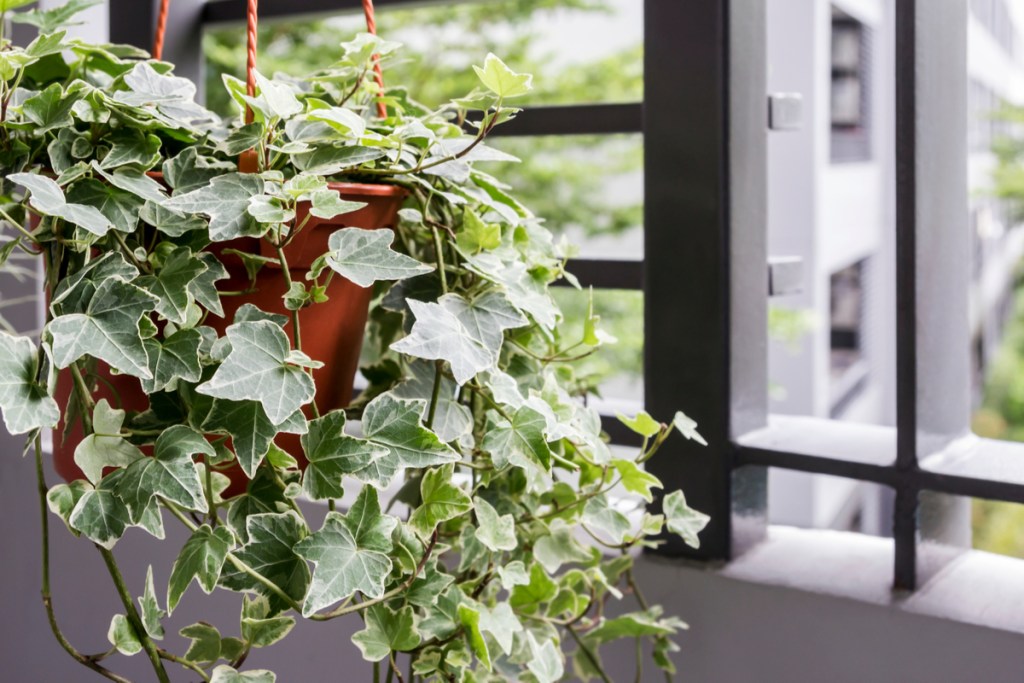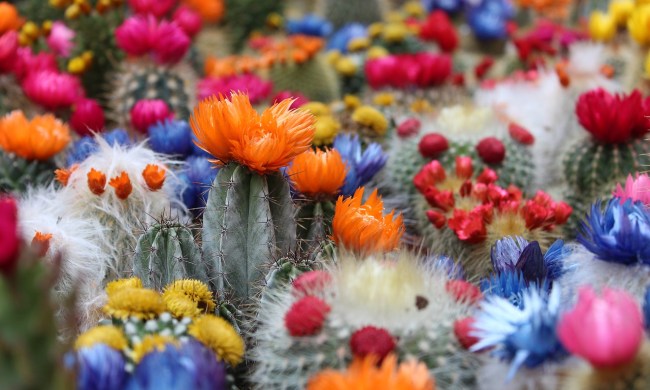Houseplants do so much for us. They brighten up our spaces, look fabulous in almost any style, and give our homes a bit of an outdoor greenhouse feel. And, like outdoor plants, they can produce small amounts of oxygen! There are some houseplants that remove toxins from the air during this process, which is especially helpful for indoor environments.
The Environmental Protection Agency notes that indoor spaces can sometimes be more polluted than cities due to factors like poor ventilation and high humidity levels. By adding some of these plants to your collection, you’ll be able to help lower the pollution in your home and help prevent any negative side effects caused by high levels of these toxins.
Chinese evergreen
Chinese evergreens are easy-to-care-for houseplants, especially because they’re well-known for being “hands off.” They’re slow-growing, causing little concern around whether or not it will outgrow the space you pick for it, and can be stable and long-lived when cared for properly. Aside from meeting the basic care needs for the Chinese evergreen, there’s one other thing you’ll need to keep in mind when growing one indoors: the lighter the variegation, the more light it needs. And this is true for a lot of plants! Because the variegations on plants contain less and less chlorophyll as they get lighter (with white being the lightest variegation), the plant will need more and more sunlight to thrive.
Well-cared-for Chinese evergreens can help filter certain toxins from the air, including benzene, carbon monoxide, formaldehyde, and trichloroethylene.
Light needs: Bright, indirect light to partial shade
Soil needs: Well-draining, slightly acidic potting mix
Water needs: Likes regular waterings, moist soil

Snake plant
Snake plants are a great option for beginner and expert gardeners alike. Smaller ones look fabulous on tabletops while a snake plant on the larger side makes for a great floor piece. Their leaves can grow anywhere from half a foot to eight feet tall, so you may find yourself keeping a snake plant around for a long time. They’re drought-resistant, able to go two to four months without water during the wintertime. These plants are relatively difficult to kill but do have a harder time in cold spaces, so be sure to keep them away from drafty rooms and windows.
Snake plants, when cared for properly, help filter certain toxins from the air, including benzene, formaldehyde, trichloroethylene, and xylene.
Light needs: Bright, indirect light with some direct sun
Soil needs: Loose, well-draining potting mix
Water needs: Let soil dry between waterings
Bamboo palm
Bamboo palms (surprisingly enough) are a palm from the Araceae and not actually bamboo. These low maintenance houseplants are native to tropical environments and as such prefer constant moisture. Bamboo palms don’t do well with under-watering but will reward you with beautiful foliage that brings a tropical atmosphere to any room.
Bamboo palms help filter certain toxins from the air, including ammonia, formaldehyde, toluene, and xylene.
Light needs: Bright, indirect lighting but can grow in any non-direct light condition, including low lighting
Soil needs: Well-draining, moist soil; peat moss or perlite can be added to standard mixes to create ideal soil mixture
Water needs: Moist but not soggy soil; sensitive to both over- and under-watering
Spider plant
Spider plants are some of the easiest and most popular houseplants out there. Because they’re quite hardy, they can tolerate a bit of neglect, which makes them great for beginner gardeners. Spider plants are self-propagating, growing runners from the parent plant that produce flowers and eventually plantlets. Spider plants have a somewhat cascading nature and are perfect plants for high shelves or hanging baskets, where the leaves and runners can hang downwards. And although they can grow in a variety of conditions, they do best when their native tropical environments are recreated as close as possible.
Spider plants help filter certain toxins from the air, including carbon monoxide, benzene, styrene, formaldehyde, xylene, and toluene.
Light needs: Bright, indirect sunlight
Soil needs: Loose, loamy soil with good drainage
Water needs: Likes regular waterings, moist soil

English ivy
The English ivy, although vigorous and slightly invasive when grown outdoors, is actually quite finicky as a houseplant. And yet, it’s surprisingly common. Ivy are sensitive to the dry indoor air found in most heated and air-conditioned spaces, so it can be difficult to recreate their ideal environment. When grown well, though, they make beautiful vines that look fabulous in a hanging basket or trained along hooks on a wall. The trick to getting them big, strong, and healthy is to give them cool spaces at night and to keep their area humid, whether through misting, a humidifier, or trays of pebbles.
English ivy helps filter certain toxins from the air, including benzene, formaldehyde, toluene, and xylene.
Light needs: Bright, indirect light
Soil needs: Well-draining, loose potting mix
Water needs: Likes regular waterings; moist, humid conditions are ideal
Golden pothos
The golden pothos is another easy houseplant that’s perfect for beginners and experts, especially if you don’t always remember to water your plants. Like the ivy, the pothos is a trailing vine plant; however, it doesn’t have aerial roots to help it cling to hooks, walls, or shelves. If you want a pothos to be a decorative vine along the wall, you’ll have to give it a bit of assistance as it grows to make sure the plant has enough support. When grown in a good environment, pothos plants can grow anywhere from 12 to 18 inches in just one month. You should make sure to properly prune and trim your pothos, as vines left to their own devices can get tangled over time.
Golden pothos plants help filter certain toxins from the air, including benzene, formaldehyde, toluene, trichloroethylene, and xylene.
Light needs: Bright, indirect light but can tolerate low lighting
Soil needs: Well-draining indoor potting mix
Water needs: Let soil dry between waterings
On their own, each of these plants can help remove small amounts of toxins while producing oxygen. If you cultivate a houseplant collection containing quite a few plants that purify air, they’ll be able to work together to clean your space and keep your home feeling fresh.


